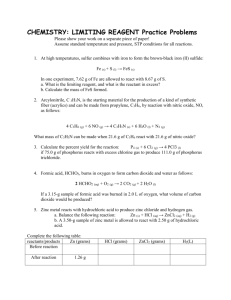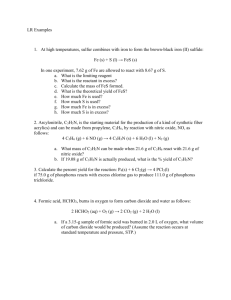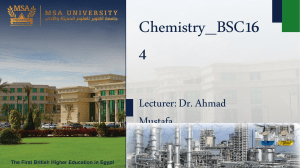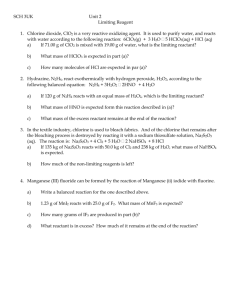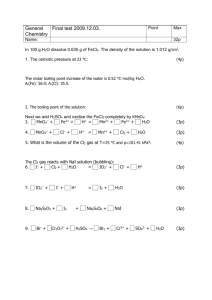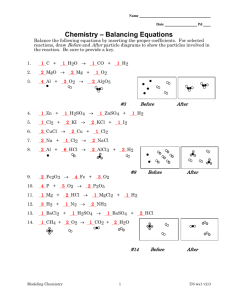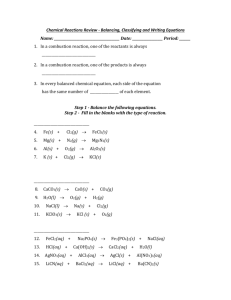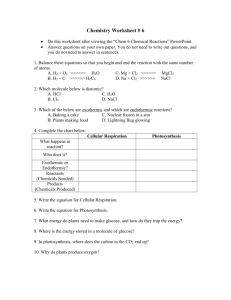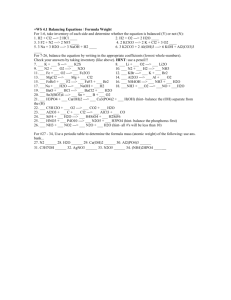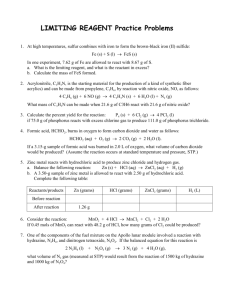Key Practice Limiting Reactant problems not due, check your
advertisement
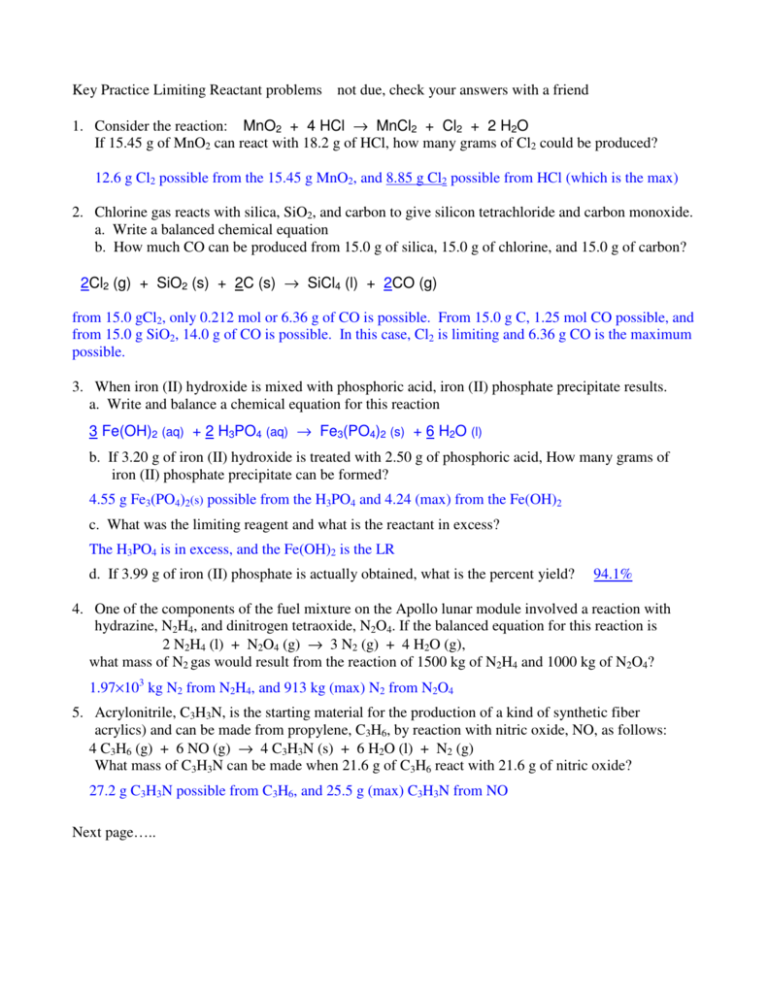
Key Practice Limiting Reactant problems not due, check your answers with a friend 1. Consider the reaction: MnO2 + 4 HCl → MnCl2 + Cl2 + 2 H2O If 15.45 g of MnO2 can react with 18.2 g of HCl, how many grams of Cl2 could be produced? 12.6 g Cl2 possible from the 15.45 g MnO2, and 8.85 g Cl2 possible from HCl (which is the max) 2. Chlorine gas reacts with silica, SiO2, and carbon to give silicon tetrachloride and carbon monoxide. a. Write a balanced chemical equation b. How much CO can be produced from 15.0 g of silica, 15.0 g of chlorine, and 15.0 g of carbon? 2Cl2 (g) + SiO2 (s) + 2C (s) → SiCl4 (l) + 2CO (g) from 15.0 gCl2, only 0.212 mol or 6.36 g of CO is possible. From 15.0 g C, 1.25 mol CO possible, and from 15.0 g SiO2, 14.0 g of CO is possible. In this case, Cl2 is limiting and 6.36 g CO is the maximum possible. 3. When iron (II) hydroxide is mixed with phosphoric acid, iron (II) phosphate precipitate results. a. Write and balance a chemical equation for this reaction 3 Fe(OH)2 (aq) + 2 H3PO4 (aq) → Fe3(PO4)2 (s) + 6 H2O (l) b. If 3.20 g of iron (II) hydroxide is treated with 2.50 g of phosphoric acid, How many grams of iron (II) phosphate precipitate can be formed? 4.55 g Fe3(PO4)2(s) possible from the H3PO4 and 4.24 (max) from the Fe(OH)2 c. What was the limiting reagent and what is the reactant in excess? The H3PO4 is in excess, and the Fe(OH)2 is the LR d. If 3.99 g of iron (II) phosphate is actually obtained, what is the percent yield? 94.1% 4. One of the components of the fuel mixture on the Apollo lunar module involved a reaction with hydrazine, N2H4, and dinitrogen tetraoxide, N2O4. If the balanced equation for this reaction is 2 N2H4 (l) + N2O4 (g) → 3 N2 (g) + 4 H2O (g), what mass of N2 gas would result from the reaction of 1500 kg of N2H4 and 1000 kg of N2O4? 1.97×103 kg N2 from N2H4, and 913 kg (max) N2 from N2O4 5. Acrylonitrile, C3H3N, is the starting material for the production of a kind of synthetic fiber acrylics) and can be made from propylene, C3H6, by reaction with nitric oxide, NO, as follows: 4 C3H6 (g) + 6 NO (g) → 4 C3H3N (s) + 6 H2O (l) + N2 (g) What mass of C3H3N can be made when 21.6 g of C3H6 react with 21.6 g of nitric oxide? 27.2 g C3H3N possible from C3H6, and 25.5 g (max) C3H3N from NO Next page….. 6. Hydrogen sulfide, given off by decaying organic matter, reacts with oxygen in the air to make sulfur dioxide and water. If 12.0 g of sulfur dioxide are formed from 7.98 g of hydrogen sulfide and 15.0 g of oxygen, what is the percent yield? 2H2S(g) + 3O2(g) → 2SO2(g) + 2H2O(g) 20.0 g SO2 possible from O2 and 15.0 g (max) possible from H2S, so % yield = 80.0% 7. When chlorine dioxide gas reacts with liquid water, the products are aqueous chloric acid and hydrochloric acid. What mass of chloric acid, in kg, can be made from combining 62.5 kg of chlorine dioxide and 13.5 kg of water? ClO2(g) + H2O(l) → HClO3(aq) + HCl(aq) 78.3 kg of HClO3 from ClO2, and 63.3 kg (max) HClO3 from H2O 8. What mass of precipitate (in g) can be made from combining a solution containing 18.0 g of silver nitrate with 32.4 g of iron (III) chloride? (See chapter 4 for a table of solubility rules) 3AgNO3(aq) + FeCl3(aq) → Fe(NO3)3(aq) + 3AgCl(s) 84.7 g AgCl possible from FeCl3, and 15.1 g (max) from AgNO3
